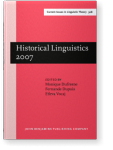Historical core vocabulary: Spring and/or anchor
On tendencies and mechanisms of language evolution
This paper argues that lexis evolution is guided by certain internal impulses generated and stimulated by the processes taking place in its historical core (HCV) comprised by the lexemes dating back to the earliest stages of the language history and characterized by simple morphological structure, stylistic neutrality, polysemy, high derivational potential, and high frequency.1 Diachronic research of the lexes of two cognate languages – English and German – demonstrated that these characteristics not only account for the HCV longevity but also ensure its structural, semantic, and functional centrality, and consequently, evolutionary significance. The study demonstrated that the role the HCV plays in lexis evolution is twofold. On the one hand, the interplay of its inherent characteristics, that ensured its structural and semantic ties with the entire lexis, makes it a stabilizing factor. On the other hand, the same attributes alongside with intense developmental processes in the HCV which are disseminated throughout the system make it a powerful dynamic factor.
